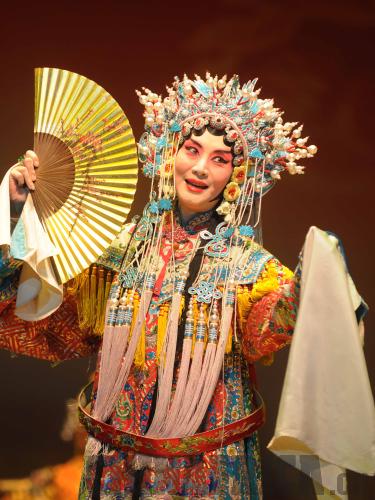|
 |
|
ELEGANTLY BEAUTIFUL: Well-known Peking Opera actress Wang Runjing performs in the famous play Drunken Beauty SONG JIANHAO |
Peking Opera was recently inscribed on UNESCO's Representative List of the Intangible Cultural Heritage of Humanity. The decision was made during the fifth session of UNESCO's Inter-governmental Committee for the Safeguarding of the Intangible Cultural Heritage held at the end of last year in Nairobi, Kenya.
At the session, the committee examined 47 nominations from 29 countries. In order to be added to the list, the submissions must comply with a series of criteria, including contributing to spreading the knowledge of intangible cultural heritage and promoting awareness of its importance. Nominees for the inscription must also justify protective measures taken to ensure their viability. Peking Opera qualified in all these aspects.
"The successful application of Peking Opera has far-reaching significance," said Shang Changrong, Chairman of the China Theater Association and one of China's most outstanding Peking Opera performers. "It not only shows full recognition from the outside world of the colorful intangible cultural heritage of China, but also shows their trust and affirmation of our efforts in protecting it."
Exporting culture
Compared to other operas, Peking Opera is relatively popular in China. Some people wonder why this popular opera still needs UNESCO's affirmation. Qian Rong, Director of the Beijing Intangible Cultural Heritage Protection Center, said the opera was presented for world intangible cultural heritage because it has been passed down for more than 200 years and the emphasis is laid on "inheritance."
Different from the situation of Kunqu, another kind of traditional Chinese opera, Peking Opera's admission does not mean the opera is declining. Kunqu has experienced faster and prominent development since its listing as a UNESCO intangible cultural heritage in 2001. Before that, it had been dying out. Peking Opera, on the other hand, is looking forward to better development and protection.
After hearing of the listing of Peking Opera, Yang Chengwei, Chairman of Peking Opera Theater of northwest China's Gansu Province, said he was very excited. "Its successful listing is a piece of very good news for local Peking Opera troupes. More people will pay attention to it and support it and its social influence will be greatly enhanced by the inscription. I believe it will change the situation of many local Peking Opera troupes. Only by improving our ability to survive can we inherit and develop Peking Opera in a better way."
The beauty of China's Peking Opera was made known to the rest of the world partly due to world-known Peking Opera maestro Mei Lanfang's enthusiastic efforts. He toured Japan twice (1919 and 1924), the United States once (1930) and the former Soviet Union twice (1932 and 1935).
Although he was not the first person to perform Peking Opera overseas, he was the first to make Western art circles sit up and take notice of China's traditional opera and recognize it as an art form in its own right. The year 2010 marked the 80th anniversary of the great cultural event when Mei performed Peking Opera in the United States.
"It's very important for traditional culture to go out. The essence of foreign art floods into China and our national opera should also go out. In that way we can have mutual communication and learn from each other. It could also bring about a boom in China's culture industry," said Mei Baojiu, Mei Lanfang's youngest son, a prominent Peking Opera actor and also head of Mei Lanfang Peking Opera Troupe. He said the popularization of traditional culture should focus on primary education about Peking Opera for children.
More efforts are now being made to protect and develop Peking Opera in the country. The Beijing Municipal Bureau of Culture hosts a series of activities such as performing, selecting new talent and holding forums on Peking Opera from November 2010 to February 2011. The successful listing will also promote further development of the art form. The Beijing Municipal Bureau of Culture, for example, will give preferential treatment to Peking Opera inheritors, which means these inheritors will receive a 20,000 yuan ($2,941) subsidy each year from 2010 to 2014. And a digital Peking Opera database is now being planned.
In addition, from 2011 to 2013, the China Peking Opera Museum will be constructed at an investment of up to 30 million yuan ($4.4 million).
An ABC of Peking Opera
> Peking Opera, which originated in the late 18th century, is a synthesis of stylized action, singing, dialogue and mime, acrobatic fighting and dancing to represent a story or depict different characters and their feelings. As a harmonious combination of Grand Opera, ballet and acrobatics, it also presents the audience with an encyclopedia of Chinese culture through unfolding stories, beautiful paintings, exquisite costumes and martial arts. It is the most influential and representative of all operas in China.
In Peking Opera, there are four main types of roles: sheng (male), dan (young female), jing (painted face, male) and chou (clown, male or female). The characters may be loyal or treacherous, beautiful or ugly, good or bad, their images being vividly manifested.
Peking Opera can be divided into two different types characterized by singing or martial activities featuring acrobatics and stunts. Some repertoires are a combination of both. It has chang (singing), nian (dialogue), zuo (acting) and da (martial arts) as its basic performing forms. Generally speaking, every sound is sung, every move is danced, no realistic interpretation is allowed and no real-life apparatus or tools are allowed on the Peking Opera stage.
One of the most well-known aspects of Peking Opera is the facial make-up, which is rich and varied, depicting different characters and remarkable images. For example, a red face usually depicts heroic bravery, uprightness and loyalty; a white face symbolizes a sinister, treacherous and guileful character and a green face connotes surly stubbornness, impetuosity and lack of self-restraint. |